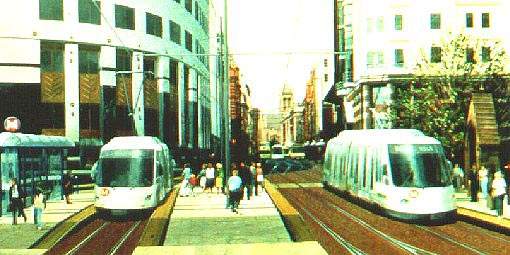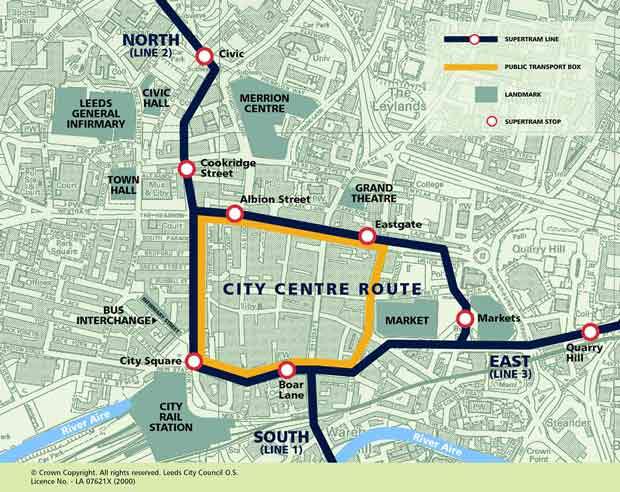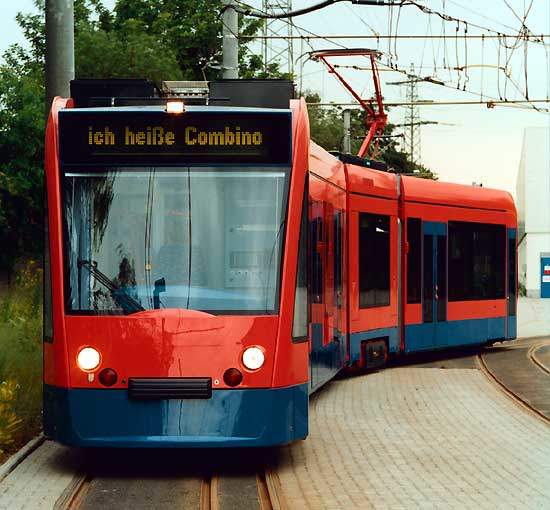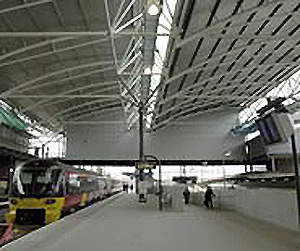Leeds is one of the fastest growing cities in the UK and suffers from chronic road congestion at peak times. It has an extensive heavy rail suburban network serving nearby towns in the West Yorkshire conurbation. However, from the early-1990s and the development of Supertram light rail network in nearby Sheffield, transport and municipal authorities in Leeds have expressed a desire to see a similar system in their city.
The project has now had bids for government funding turned down twice, once in the mid-1990s and again at the end of 2005. The latter is despite provisional approval in 2001, part of a scheme to increase light rail use in the UK by 50% over the following decade. Low-cost guided buses running in the same corridor are now being actively pursued.
The government insisted that the cost of the project should not exceed £500 million, and at the end of 2005 called for the project to be halted despite the advanced nature of procurement, having learned that it might cost twice the agreed sum. A total of 75% of the funding was required from the public sector, with contributions from central government, the government-sponsored but independently-thinking passenger transport executive, and the city council. The balance would be met from the private sector.
The concession allowed four years for construction, and 27 years of operations, and the concessionaire could recover its initial investment from progress payments and surpluses in operating revenues.
Infrastructure
A £500 million, three-line, 28km (17-mile) system was proposed with a city centre core section branching off to serve the north, east and south of the city.
The northern branch (Line 2) is via the city’s universities and Headingley to a park and ride site at Lawnswood. To the east, Line 3 trams will run via Burmantofts and St James Harehills to Seacroft and Whinmoor, while south of the city centre Line 1 served Hunslet, Middleton and a park and ride facility at Tingley, with another park and ride site at Stourton, close to the M621 motorway.
Leeds Supertram was promoted by Metro, the West Yorkshire Passenger Transport Executive (PTE) as its number one priority transport project. It is specifically for corridors that are not well-served by the heavy rail network and see heavy demand for bus services.
With 28km (17 miles) of double track, 75% of which should be segregated from other traffic on reserved / segregated track, with the rest including street-running, Leeds Supertram would be a major undertaking. There would be around 50 tram stops with level boarding at platforms to make the trams accessible to all.
Four large park-and-ride sites have been planned, with 3,000 car parking spaces at Stourton, and 500 each at Tingley, Lawnswood and Grime’s Dyke.
Other major traffic generators are the Royal Armouries and Clarence Dock developments south of the city centre and Headingley (for the Yorkshire County Cricket ground, Leeds rugby league stadium and the Seacroft Centre in east Leeds). In the city centre, trams would serve the bus and rail stations, universities, hospitals and major shopping areas.
In common with other UK projects, development would be a design, build, operate, maintain and part-finance relationship, with a combination of government money and Private Finance Initiative (PFI) funding.
Rolling stock
A total of around 40 articulated trams, capable of comfortably carrying up to 200 passengers, would be needed for the three routes.
It is now common practice to employ standard-sized vehicles which are available off the shelf from companies such as Alstom, Bombardier, Siemens and Stadler. The operating speed is 70km/h (45mph) with a floor height of not more than 350mm above the rail at entrances, providing level boarding access.
Signalling and communications
Conventional light rail systems are controlled by absolute block signalling, managed from a central signalling centre at or near the main depot.
The future
In common with UK light development projects, the revival of Leeds Supertram requires a sea change in procurement processes to ensure that it is perceived as good value for money. In the meantime, an alternative scheme of running low-cost guided buses running in the same corridors is now being actively pursued. If ridership figures become overpowering, the case for light rail will be strengthened.
Leeds Supertram attracted interest from most of the world’s big name companies. Although no deals were struck, the final shortlisted bidders were Airelink (Arriva, Siemens, Amec and Transdev) and Momentis (First, Bombardier, Bouygues and Jarvis). They represented dozens of the world’s leading transport, design, engineering and finance companies with experience of PFI and DBOM contracts and operating light rail systems across the world.
The West Yorkshire Passenger Transport Executive has looked at long-distance extensions to Wakefield, Bradford, Halifax and Huddersfield.











